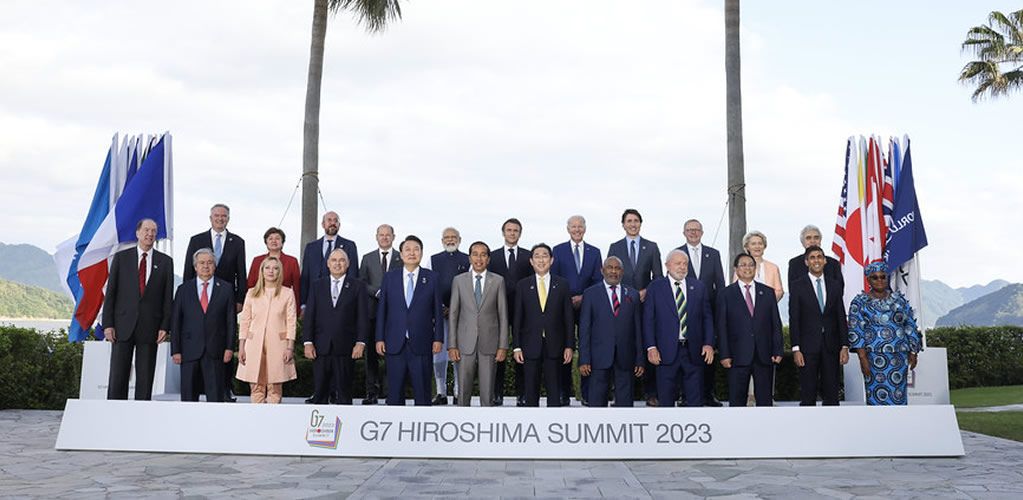G7 summit in Hiroshima will force world leaders to confront the continuing nuclear threat
The heads of some of the most powerful countries in the world would be wise to listen to the devastating testimony of Hiroshima survivors.

The heads of some of the most powerful countries in the world would be wise to listen to the devastating testimony of Hiroshima survivors.
📌 The main points...
- Hiroshima hosts the G7 summit, giving world leaders a chance to meet atomic bomb survivors.
- Japanese PM Fumio Kishida emphasizes Hiroshima’s significance. His action plan aims to strengthen the non-proliferation treaty of 1970.
- Third-generation survivors faced discrimination and censorship, but many contributed to rebuilding Hiroshima.
- G7 leaders are urged to sign Kishida’s action plan and prioritise peace over weapons of mass destruction.
T he current crises facing the world will be brought into sharp relief as Hiroshima – the first city to be annihilated by a nuclear bomb – plays host to the annual G7 summit of seven of the world’s wealthiest countries. Crucially, leaders will have a rare opportunity to meet face-to-face with survivors who still want to tell their stories to the world.
Forever branded on the collective consciousness, Hiroshima has become a symbol of resilience in the face of nuclear destruction. It is also home to a large population of hibakusha, as the survivors of the atomic bomb are known. There are estimated to be 118,935 hibakusha in Japan, with 39,590 still living in Hiroshima.
That the G7 meeting is being hosted in the city is down to Japanese prime minister Fumio Kishida. A son of Hiroshima, he has consistently emphasised his city’s significance rather than shy away from its historic horrors.
As foreign minister, he helped arrange the US presidential visit to Hiroshima in 2016, when Barack Obama met with survivors. After announcing this year’s G7 in Hiroshima, Kishida put forward his Hiroshima action plan which aims to strengthen and maintain the non-proliferation treaty of 1970. Kishida also vowed to invite leaders of the world to visit Hiroshima and Nagasaki so they might understand the devastating consequences of using nuclear weapons.
My work looks at how the stories of survivors can be reframed when viewed across the generations. Currently, I am interviewing the third generation, the grandchildren of survivors, known as hibaku sansei in Japanese.
Survivors are deeply sensitive to the lack of openness that surrounds the history of the atomic bombings and are often reluctant to tell their stories. I believe it is important, through repeated interviewing, to seek to understand the reasons for their silence as well as their stories, drawing on their experiences and perspectives.
War and peace
The G7 leaders are meeting at a time of escalating crises including the war in Ukraine, tensions between China and Taiwan and an accelerating international arms race.
After the second world war, Japan shied away from world politics, conscious of its loss of empire and devastating defeat in 1945, which ended with the bombing of Hiroshima and Nagasaki. This shocking act not only killed hundreds of thousands of people, but also left untold numbers of survivors with conditions that have been passed on to their descendants.
So it is refreshing to hear a Japanese leader making what seems like a bold and clear statement that the G7 summit should, in a time of war, be mainly focused on peace.
Seventy-eight years after the city was nearly bombed out of existence, Hiroshima now has beautiful parks, memorials and museums that exhibit the materials and human stories about the bomb. At the time it was predicted that nothing would grow in the city for decades.
Understandably many survivors moved out or emigrated in the aftermath of the bomb, but some, in extremely difficult circumstances, went on to carry out vital research into the effects of the atomic bombing on the environment and geology of the city.
Some created harrowing works of art that depicted personal torments, while others patiently went about conducting medical research and treating survivors, resulting in the care homes and hospitals that now look after thousands of elderly hibakusha.
They wanted to help their fellow citizens but they also hoped their efforts would one day bring the world to the regenerated city. It has taken a Hiroshima man, Fumio Kishida, to become prime minister to fulfil their wish.
Surviving to tell the tale
The survivors who rebuilt the city and preserved the memories of the atomic bombings for future generations did so at huge personal cost.
Eighty-six-year-old Keiko Ogura, an official storyteller in the city, was just eight and at home in a suburb of Hiroshima when she was exposed to radiation, including from the deadly “black rain” that fell from the mushroom cloud on August 6 1945. She has relentlessly followed in the footsteps of her husband, Kaoru Ogura, one of the first directors of the Hiroshima Peace Memorial Museum, in bringing the hibakusha stories to the rest of the world.
When I interviewed her for my study, she said that telling her own story of being exposed to the atomic bomb had caused her profound anxiety. Hibakusha grew up in a culture of discrimination and censorship.
In the aftermath of the bombing, both the Japanese military government and the US occupation sought to erase any mention of the seismic event, deny the lethal effects of the bomb on the human body and censor survivors’ stories.
As Kyoko Gibson, 75, who lives in the UK but is from Hiroshima, said recently in a talk: “Can you imagine if you had to watch those you care for undergoing excruciating suffering?” The hibakusha were determined not to be seen simply as victims and submit to becoming the unfortunate collateral damage of Japan’s surrender on 15 August 1945.
Nobel Prize-winning author Kenzaburo Oe (1935-2023) described in successive autobiographical works how his life was changed for the better by a conversation with a hibakusha he interviewed for his 1965 book Hiroshima Notes. He went on to champion their cause throughout his life, arguing that the chief lesson of the bombings of Hiroshima and Nagasaki was a lesson in self-reflection.
If they listen to the harrowing stories of survivors in Hiroshima, the G7 leaders might find, emotionally and rationally, that signing up to Kishida’s action plan and an attendant agreement on the policy of no first use is the only moral option.
This could help create much-needed space for proper debate across divides. Will they take this opportunity? At the moment the biggest threat to world peace is arguably still what philosopher Bertrand Russell and physicist Albert Einstein described in 1955 as the threat to us all: weapons of mass destruction. The stories of Hiroshima’s hibakusha should stand as an enduring warning against this grave human folly.

— AUTHOR —

|
▫ Elizabeth Chappell, PhD Candidate, Department of English Language & Literature, The Open University. |

|

|

|
Sources
▪ Text: This piece was originally published in The Conversation and re-published in PMP Magazine on 20 May 2023. | The author writes in a personal capacity.
▪ Cover: Flickr/Number 10. - G7 in Hiroshima, Japan. | 20 May 2023. (Licensed under a Creative Commons Attribution-ShareAlike 4.0 International License.)






[Read our Comments Guidelines]